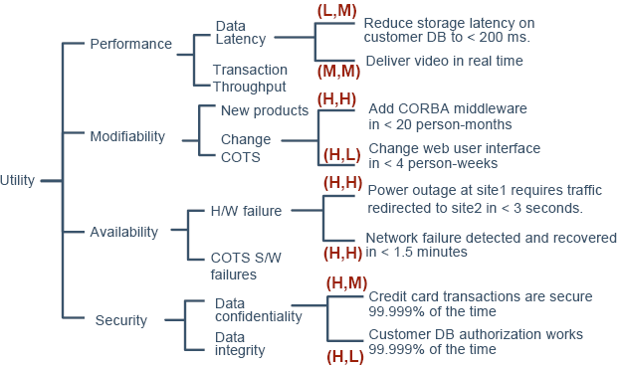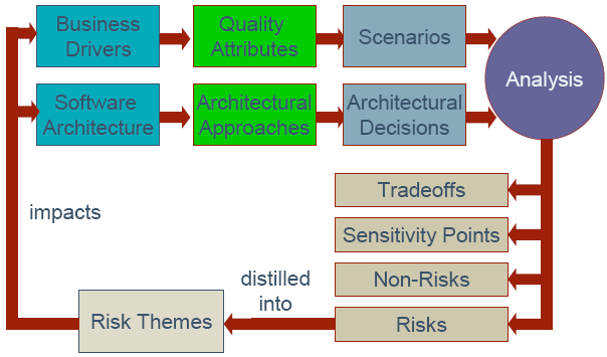TreeviewCopyright © aleen42 all right reserved, powered by aleen42
ATAM (Architecture Tradeoff Analyse Method, 架構權衡分析法) Back
- 評價軟件體系結構初稿是否滿足需求.
- ATAM更多強調質量屬性的評估, 其主要目標是為了識別風險, 分析設計, 明確權衡點並寫入文檔.
- 權衡(Tradeoff): 指多個質量屬性之間的取捨, 從而滿足需求.
- 四個概念
- 風險: 潛在問題, 若發生則會降低某些質量屬性的部分.
- 三層架構下, 商業邏輯層的規則還沒有確定
- 沒有檢測一個關鍵組件是否正常工作的機制
- 雷達系統的每一個組件都假定有一個固定的轉動速率
- 非風險: 可以提高質量, 幫助實現目標的部分
- 假定消息的到達速率是每秒一次, 一次的處理時間小於30ms. 如果對一個更高優先級的處理, 響應時間要求是1s是可行的.
- 關鍵點/敏感點: 若改變則對質量屬性產生重大影響的部分.
- 維護系統所需的工作量和系統的通信協議以及文件格式是密切相關的.
- 權衡點: 會影響多於一個質量屬性的部分.
- 採用高強度的加密方式會提高安全性, 但影響性能
- 為了達到性能要求, 不得不在底層通信組件中使用彙編語言, 但此組件不再具有移植性
- 風險: 潛在問題, 若發生則會降低某些質量屬性的部分.
1. Purpose of ATAM
i. 引導涉眾發現系統中的權衡點, 風險等信息:
- helps stakeholders to ask the right questions to discover potentially problematic architectural decisions.
- discovered risks can be made the focus of mitigation(緩解) activities.
- tradeoffs can be explicitly identified and documented.
ii. 如果能預知風險, 則可在後期加以注意和控制
2. Benefits
- 識別風險
- 澄清質量屬性需求
- 改進文檔
- 記錄結構化設計決定
- 增進溝通
3. Phase

- Phase0: 前期準備
- 成立核心的評估小組(包含多方面的角色)
Phase1: 技术评估(Technical Evaluation)
- 以技術方面的涉眾為基礎, 對體系結構進行技術性評估
- Present the ATAM: 讓各方瞭解ATAM的基本內容
- Present business drivers: 讓客戶描述系統的商業目標
- Present architecture: 讓Architect展示體系結構的概要, 架構師, 項目經理和市場代表一起描述此系統帶來的價值
- Identify architectural approaches: 確認體系結構中對實現質量需求產生決定作用的部分
- Generate quality attribute utility tree: 畫出效用樹來理清質量屬性要求.
- (H, H): (重要程度, 實現難度)
- L: LOW
- M: MIDDLE
- H: HIGH
- Root: Utility
- 1st Layer: Quality Attributes
- 2rd Layer: Word
- 3nd Layer: Description from the context(Scenarios: stimulus + Environment + responses)
- Use Case Scenarios: anticipated uses of the system
- Remote user requests a database report via the Web during peak period and receives it within 5 seconds.
- Growth Scenarios: anticipated changes of the system
- Add a new data server to reduce latency in scenario 1 to 2.5 seconds within 1 person-week.
- Exploratory(探究性) Scenarios: unanticipated stresses to the system
- Half of the servers go down during normal operation without affecting overall system availability.

- Half of the servers go down during normal operation without affecting overall system availability.
- Use Case Scenarios: anticipated uses of the system
- (H, H): (重要程度, 實現難度)
- Analyse Architectural Approaches
- 找到可以滿足最高優先級質量需求的體系結構設計方法
- 針對場景(H, H), 詢問與質量屬性密切相關的問題
- 確認四要素(風險, 非風險, 關鍵點和權衡點)
- 以技術方面的涉眾為基礎, 對體系結構進行技術性評估
Phase 2: 以涉眾(Stakeholders)為中心
- 探討出Stakeholder對第一階段結果不同的意見
- Recap Phase1
- Brainstorm and prioritize scenarios
- 通過頭腦風暴, 對質量屬性進行投票, 並決定每個Scenario的(H, H)標籤
- 每人 (0.3 * #Scenarios) 的票
- Analyse architectural approaches
- 分析從上一步所決定的Scenario對體系結構的影響
- Present results
- 概括和總結ATAM的所有步驟
- Brainstorm and prioritize scenarios
- Phase 3: 為客戶撰寫最終的報告
4. Conceptual Flow

Software Architecture Evaluation Methods
- SAAM(Software Architecture Analysis Method) Founded on Complex Scenarios(SAAMCS)
- consider the complexity of evaluation scenarios as the most important risk assessment factor.
- Extending SAAM by Integration in the Domain(ESAAMI)
- integrates SAAM with domain-specific and reuse-based software development processes.
- SAAM for Evolution and Reusability(SAAMER)
- focus specifically on the quality attributes of evolution and reusability.
- Scenario-based Architecture Reengineering(SBAR)
- utilize scenarios, simulation, mathematical modeling, and experience-based reasoning for assessing quality attributes. And also incorporates an architecture desgin method.
- Architecture Level Prediction of Software Maintenance(ALPSM)
- analyse maintainability using scenarios, called change scenarios, which represent maintenance tasks.
- Software Architecture Evaluation Model(SAEM)
- is based on formal and rigorous quality requirments.
As the plugin is integrated with a code management system like GitLab or GitHub, you may have to auth with your account before leaving comments around this article.
Notice: This plugin has used Cookie to store your token with an expiration.